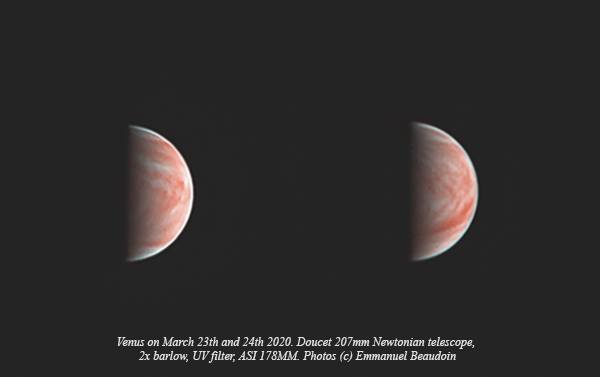Although Venus is the third brightest object of our sky after the Sun and the Moon, this planet is not as mesmerizing as Saturn, Jupiter or Mars when observed through a telescope. Its highly-reflective atmosphere is so bright that it looks like a featureless white dot.However, an amateur Astronomer managed to capture mind-blowing pictures of Venus' clouds with a rarely-achieved level of sharpness from the ground. Even more mind-blowing when the equipment required for this performance was only an 8" Newtonian telescope. What is the secret of these images? Let us have a closer look at this outstanding work.
Venus at greatest eastern elongation on March 24th 2020
Over the past few weeks, the closest planet to Earth, Venus, has been rising up in the sky to reach its highest separation from the Sun. This particular configuration is called Venus's greatest elongation and occurs when the angular separation between the Sun and Venus - as seen from the Earth - is at its maximum peak ; meaning that Venus is farther away from the Sun in the sky than at any other time. For Earthling observers, such elongation is more than welcomed since it enables more observing time of the planet either after sunset for an eastern elongation or either before sunrise for a western elongation. Also, farther a celestial object is away from the Sun, better the night-time observation is, since you can wait longer for the sky to be dark while the object is still high above the horizon.
This is why a greatest elongation of a planet is likely the perfect period for taking the best of planetary imaging.
 |
The IR light (red color) highlights the atmosphere whereas the UV light (white color) unveils the cloud coverage of Venus.
The difference of appearance from one night to the other are caused by the high-speed winds
of the Venus atmosphere (>350 km/h). Photos by Emmanuel Beaudoin.
|
★ A technical achievement in Amateur Astronomy
On March 23 and 24 2020, a French amateur astronomer from Paris area, Emmanuel Beaudoin, pointed a 207-mm-diameter telescope towards Venus. The outcome is simply mind-blowing: the two pictures reveal the subtle change of shades and structures of Venus' clouds from one night to the other.
Venus is not the easiest target of our Solar System to capture with a telescope, mainly because of its apparent diameter. Smaller than Saturn or Jupiter, the angular diameter of Venus is only about 23.5 arcsec. In other words, it is similar to zoom in a 1-euro coin from a distance of 206 meters!
At this low angular distance level, even the lowest optical defects can compromise the details you expect to get of a planet: from the Earth's atmospheric distortion to the optical quality and stability of your telescope. In the first case, the atmospheric disturbance can not be controlled - at least not at the scale of an amateur astronomer - so Emmanuel Beaudoin took the best of the atmospheric conditions over Paris and of the forthcoming greatest eastern elongation of Venus.
Added to these extremely good seeing conditions, the impressive quality of the images relies on other major points we develop thereafter.
Added to these extremely good seeing conditions, the impressive quality of the images relies on other major points we develop thereafter.
★ Imaging technique
The unusual colors of these images might not be familiar to you, since they are false colors. In fact, Emmanuel did not collect the broadband light of the whole visible spectrum but carefully selected parts of it. He employed filters that are specifically designed to enhance and pop up the faint details of the Venus' clouds: the blue and green layers of these images make the clouds visible thanks to an Ultraviolet (UV) filter whereas the red layer shows most of the reflected light of Venus thanks to an Infrared (IR) filter .
- The first one, the UV filter, enables astronomers to get all the information on the cloud coverage. As the atmosphere of our neighbor planet features a high density of CO2, a high amount of infrared sunlight is reflected. The only way to get rid of this peak of light and to get details of the fainter clouds within the atmosphere is to use shorter wavelength such as the Ultraviolet light. Although the UV filter gives a resolution high enough to spot the clouds on Venus, its limited band-pass strongly affects the amount of the light collected.
- On the other hand the IR filter aims to collect most of the light that Venus sends us - the light we receive from Venus is purely sunlight reflected onto its atmosphere. Therefore, capturing the Infrared light catches up with the low intensity level captured by the previous UV filter.
Finally, as for deep sky astrophotography, planetary imaging requires a lot of individual frames to be stacked together in order for digital noise and seeing effects to be mitigated. However, as Solar Systems planets are brighter than deep sky objects, they only need lower-than-second exposure time. This can be done at higher frame rate using short video clips. The astrophotographer here recorded 2 minutes videos for each filter.
★ Equipment
Emmanuel Beaudoin used a ASI 178MM camera with a x2 Barlow lens mounted on a hand-crafted Newtonian Telescope. And here, the adjective hand-crafted means a lot!
This instrument was indeed entirely built, both mechanically and optically, by astronomer André Doucet. André was an astronomer working for the Paris Observatory and had become an expert in telescopes hand-crafting. He built this 207-mm-diameter Newtonian with the only purpose of making it suitable for performing high-resolution imagery. The mirrors were specifically polished to reach the highest optical quality as possible with the lowest surface errors. Also, the secondary mirror of this Newtonian reflector is not held by a standard mechanic support - called "spider"- but instead, is attached to a plane lens. As for Maksutov telescopes, this optical front-window has the benefit from being diffraction-free, in contrast to a spider which generates typical diffraction spikes around the image of the star decreasing the resolving power.
Note: The surface error of the primary mirror was controlled at λ/40 RMS. This one-off telescope can reach an overall level of resolution of λ/25 RMS on-sky!
Such a telescope has then a far better resolving power than any commercial telescope either of the same diameter or even larger! Consequently, high-resolution astronomy does not only rely on having a large diameter mirror but also on having perfect optics, good mechanical stability, perfect atmospheric seeing, and an experienced amateur astronomer!
★ About the photographer...
Emmanuel Beaudouin is a passionate amateur astronomer from Paris area (France), a physics researcher and an experienced astronomy communicator. He has led multiple conferences, workshops and wrote several books dedicated to the general public.
Find out more about Emmanuel's work on his website: http://www.astrosurf.com/beaudoin/







awesome !!!!
RépondreSupprimer